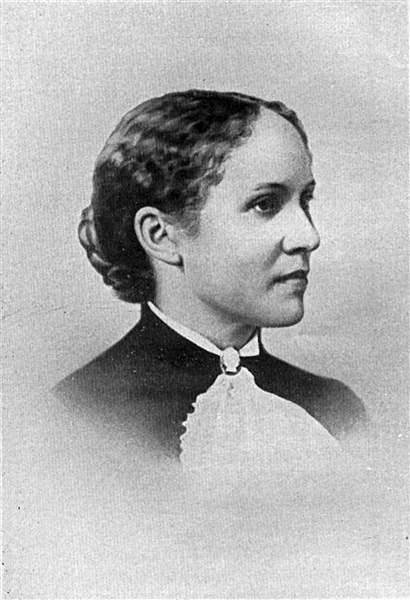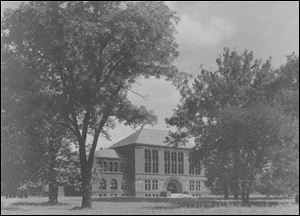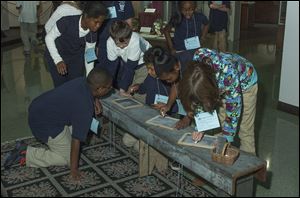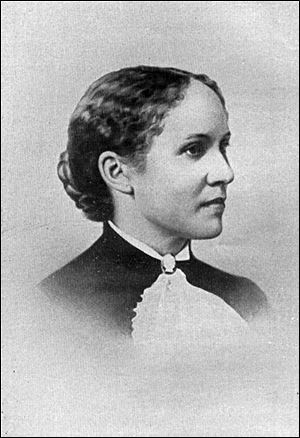
PRESIDENTIAL CENTER
Exhibit shows Hayes' devotion to education
11/24/2013
Olivia Davidson is the student who was sponsored by First Lady Lucy Hayes at Hampton Institute.

Hayes Hall at The Ohio State University.
FREMONT -- Born into a family with limited education, Rud Hayes’ mother and uncle were adamant that the boy, and to a lesser extent his sister, Fanny, would get good educations.
Sophia Hayes enrolled the children in school in Delaware, Ohio, and when Rud was 14, sent him to boarding schools with the financial help of her brother, Sardis Birchard, a businessman. Fanny’s formal schooling ended at about 14.
Rud’s mother insisted he return to Ohio after high school “to be a western man,” so he went to Kenyon College in Gambier and graduated as valedictorian. At 22, he completed Harvard’s law school, returned to Ohio, and worked as an attorney, sometimes representing runaway slaves.
He served as a Civil War soldier (enlisting at 37), then as congressman. In the first term of his 12 years as Ohio’s governor, he pushed the state’s congressmen to establish a state university. The Ohio Agricultural and Mechanical College was chartered in 1870, opened in 1873, and in 1978, became the Ohio State University.
At 53, Rutherford B. Hayes was an attractive candidate for president. He was heroic (he’d been wounded five times in battles), believed in humanitarian reforms, was gregarious, and had a charming wife and children. He promised to run for just one term and won, serving from 1877 to 1881. He would become every bit as committed to education as his mother and Uncle Sardis had hoped. (Rud’s father, a distiller, had died before he was born).
Indeed, his final act before his death to a heart attack in 1893 was a trip to Cleveland to interview candidates for a dean’s position at OSU, where he was a trustee.
An exhibit at the Hayes Presidential Center in Fremont, Rutherford B. Hayes, Buckeye President, through April 13, explores his commitment to education and his love of Ohio.

Students explore a 19th-century-style classroom at the Hayes Presidential Center in Fremont.
A 19th-century-style classroom with chalk tablets, a pot-bellied stove, and a tall Dunce cap greets visitors at the bottom of the stairs; it’s similar to one that young Rud and Fanny would have attended in Delaware in the 1820s and ’30s. Text panels and images on the walls explain some of the work he did on behalf of education, including jottings in his own hand.
He set the tone in his inauguration address, saying “universal suffrage should rest upon universal education.” Since African-American men had the right to vote, it followed that they should also have the right to an education. In addition, Lucy Webb Hayes was the first First Lady to have earned a college degree, from Wesleyan Women’s College in Cincinnati.
While in Washington, the couple often visited the Hampton Institute in Virginia, which educated African-Americans. After one of Mrs. Hayes’ trips there, she decided to sponsor the education of a student, an Ohioan named Olivia Davidson who would later marry Booker T. Washington and help him establish the Tuskegee Institute in Alabama.
President Hayes also worked to established the Carlisle Indian Industrial School in Pennsylvania, the first off-reservation boarding school for Native Americans.
“At the time, the thought was this was very beneficial,” said Christie Weininger, executive director of the Hayes Center. “As historians, we look back on it with a somewhat critical eye.”
White reformers, who were often Christian missionaries, believed that assimilating Indian children and teaching them to speak, dress, and act like white people would make them successful in mainstream America. “It was very patronizing, but was thought to be progressive,” said Ms. Weininger.
In 1881, the Hayes returned to their beloved Fremont home where there were cows, chickens, dogs, and gardens. He began giving speeches, hundreds of them, all over the country on issues that stirred his passions.
“He felt he was a reformer. He liked to cause change and he felt that talking [explaining the need for reform] itself helped make change,” she said.

Olivia Davidson is the student who was sponsored by First Lady Lucy Hayes at Hampton Institute.
Education was a key concern. He believed everyone should learn a manual craft, something useful and enjoyable. It would build a good work ethic and give people the feeling they were accomplishing something. He also hoped it would help diminish the vast disparity between rich and poor, lamenting in his diary in the late sixties that the country was becoming a nation “of the corporations, by the corporations, and for the corporations.”
He also advocated prison reform (suggesting the separation of young, first-time offenders from career criminals), equal rights for minorities, and veterans benefits. Mrs. Hayes pitched in by soliciting donations of furniture, clothing, and kitchenware for a home and school for Civil War veterans in Xenia. He attended an annual conference on the welfare of Native Americans and African-Americans, which influenced government policy and shaped attitudes.
In 1887, he was appointed to the board of trustees at OSU at a time when the trustees had a hands-on role in running the young institution. He raised money and spoke to the state legislature about not cutting its funding. Named for him, Hayes Hall is the oldest classroom building on the campus and is on the National Register of Historic Places.
Information: 800-998-7737 and rbhayes.org.
Contact Tahree Lane at tlane@theblade.com and 419-724-6075.